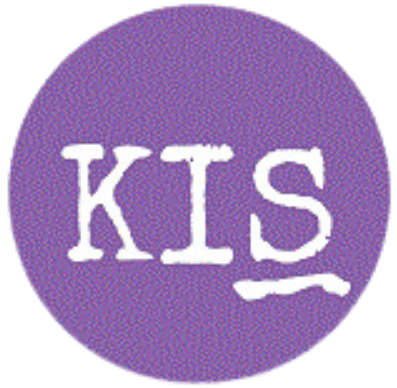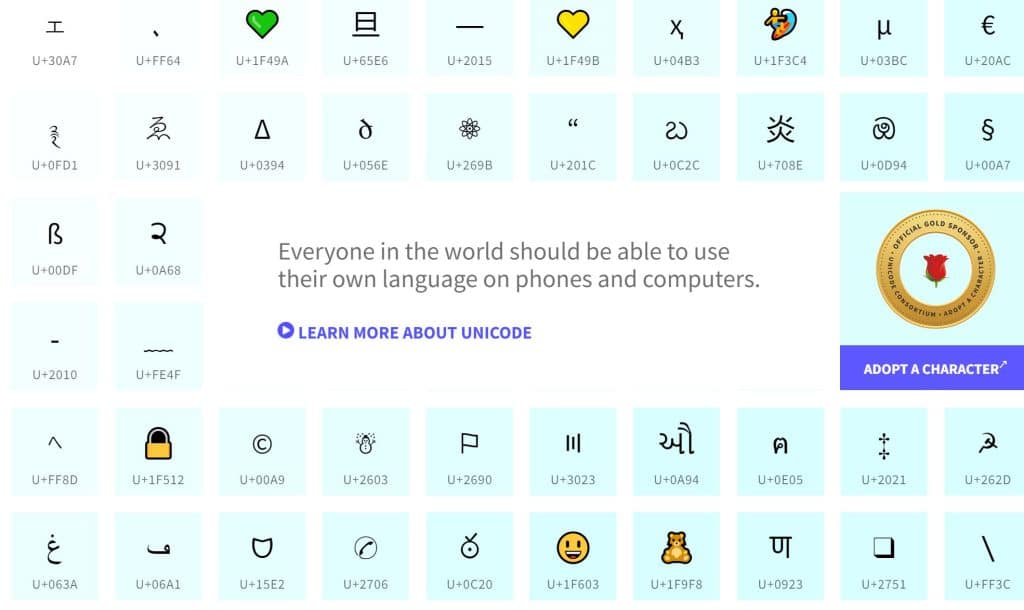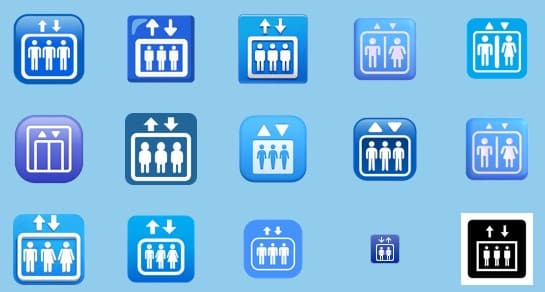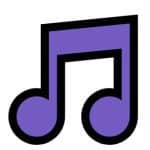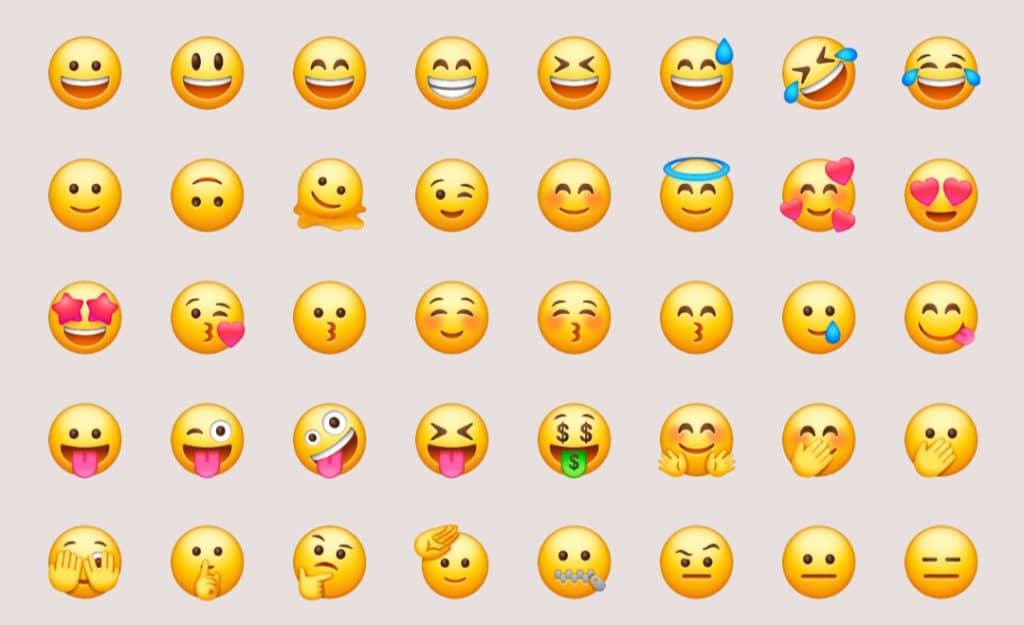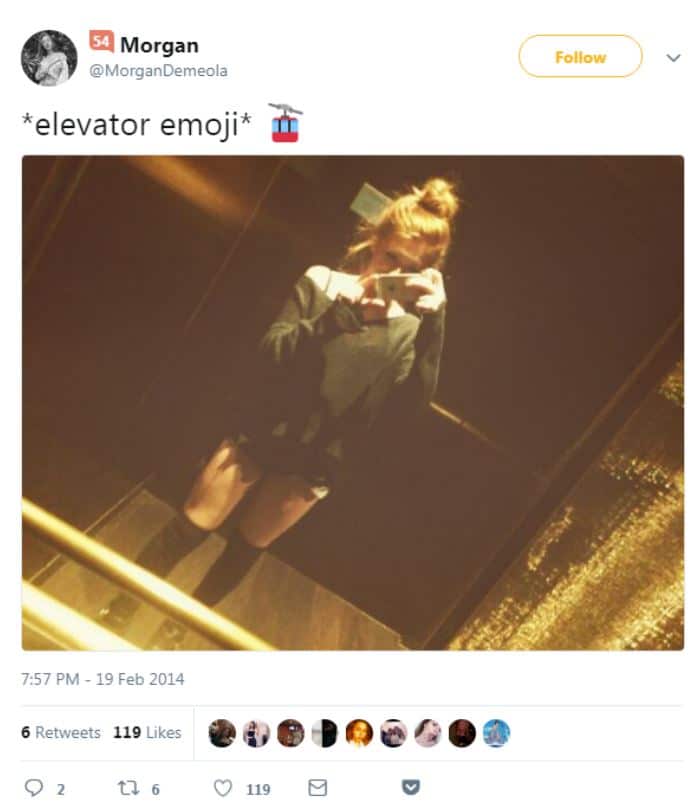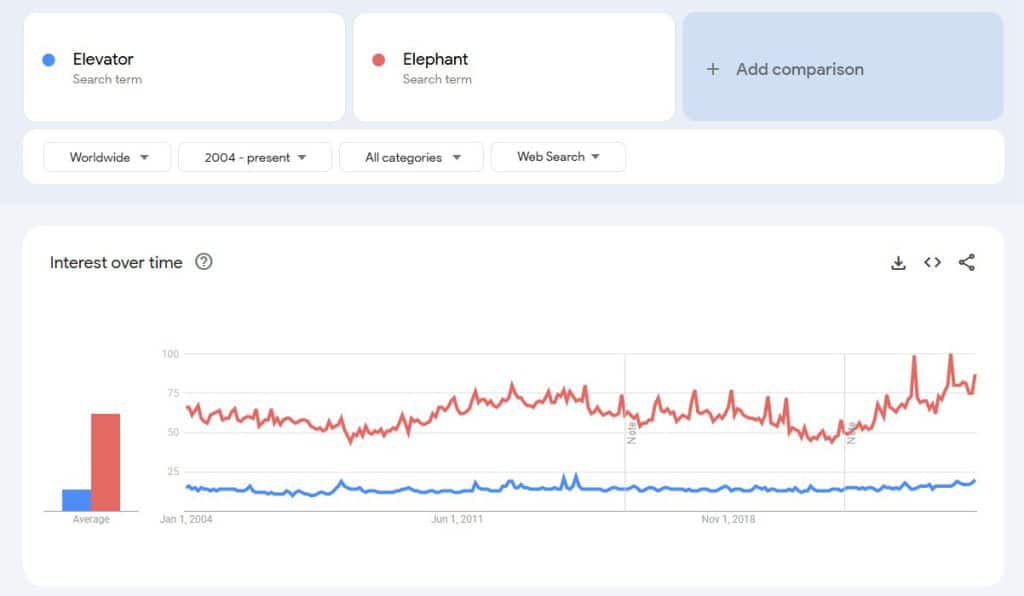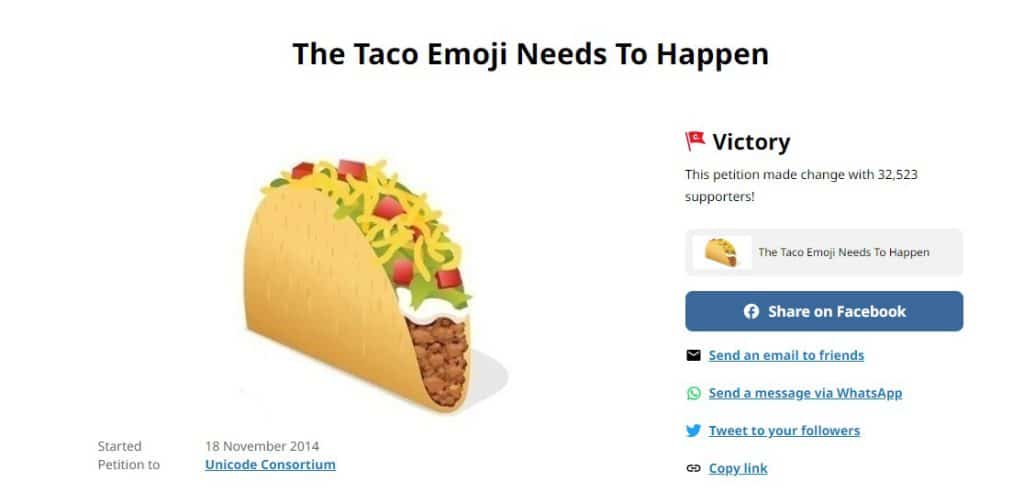How do new emojis get added to your phone? Speaking as someone who submitted an emoji proposal to Unicode, I know the ins and outs of the process!
Here’s everything you need to know about requesting an emoji idea.
Everyone’s got one awesome fact that when they tell it, everyone goes, ‘Oh wow, that’s so cool!’
Perhaps you’re related to someone famous or competed in an event with a million-to-one chance of winning.
My amazing fact? I successfully submitted an emoji proposal.
Yep, if you’ve ever used the lift (or elevator for our American friends) emoji on WhatsApp or Facebook, I wrote the proposal for it.
I know, I know, it’s not the most sexy emoji. But it’s still a pretty cool achievement nonetheless, right?
If you’ve ever wondered about the emoji proposal process or how new emojis get added, I’ve put together this comprehensive guide to talk you through how everything works.
How to submit an emoji proposal: A summary
Can’t be bothered to read through this entire article? Here are the key points:
- If you want to create an emoji that appears in everyone’s phones, the only way you can do this is to submit a proposal to Unicode (please don’t ask me!)
- This proposal details why your proposed emoji will benefit people, and how it will complement existing emojis
- Data is very important – you can’t just say ‘I think this emoji is great, so you should include it’
- Unicode won’t accept proposals for certain emojis, including flags, logos, and signs
- If Unicode accepts your proposal, the emoji will be included in a future update
How the lift emoji came to be
Many years ago, I was the marketing manager for a lift maintenance company.
We were in the office throwing out campaign ideas, and the subject of World Emoji Day came up.
(17th of July if you’re interested.)
‘Oh, we should submit a proposal for a lift emoji,’ I said.
At this point I had no idea who you had to contact to submit an emoji, how long it would take, whether you had to pay – anything.
‘That’s a great idea!’ chorused the team.
So I toddled off to see my boss, the Sales and Marketing Director, to see what he thought.
‘That’s a great idea!’ He said.
Looks like I had a new task to add to my already at-capacity to-do list.
So, I did some research and found out where you had to submit an emoji idea– an organisation called Unicode. I’ll explain who they are and what they do a little later.
I read the guidelines, drafted a proposal, and sent it off. To be fair, we didn’t expect anything to happen after that.
The aim was to put a blog post and press release out in time for Emoji Day saying we submitted a proposal, and that would be the end of the campaign.
However a little while later, I got an email back from Unicode. They liked the emoji proposal and wanted us to pad it out a little more, with the aim of adding a lift emoji to version 13.0 of the Unicode standard.
I nearly fell off my chair. I think my boss nearly fell off his chair too.
So we made some tweaks, and Unicode added the emoji proposal to the shortlist. We waited a while, and the lift emoji made the final cut.
And that, as they say, was that.
So, what is Unicode?
Unicode is the organisation that is responsible for how letters and numbers appear on devices worldwide.
Before Unicode, letters and numbers were encoded on different computer systems and in different countries in different ways. Unicode standardised things, making communication clearer and easier.
As part of its responsibilities, Unicode manages existing and new emojis. It assigns a code to each emoji, offering standardisation across different devices.
This means that if you send a smiley face emoji from an iOS device to your friend on an Android phone, nothing is lost in translation.
Can you add an emoji to the Unicode list for me?
No.
It took a lot of time and research to create the proposal, and I don’t fancy doing it again. Sorry.
Despite this, since I published this article, I get people regularly messaging me through my website asking: ‘Would you consider adding X to the emoji list?’
Please let me stress – I’m not responsible for the emoji list and have no say over which emojis get published.
Is there anyone who can write an emoji proposal for me?
If you haven’t got the time or aren’t sure where to begin, there are people who can help.
As submitting an emoji proposal is such a niche thing, there aren’t a lot of businesses that promote this as a service.
I recommend asking around on social media (LinkedIn is a good place to start). Alternatively, you can submit a proposal on a platform like Upwork or PeoplePerHour.
However, bear in mind that there is no guarantee of success. Someone could write the most watertight proposal ever, and it could still get rejected.
Submitting an emoji proposal? Here’s what you need to do
An emoji proposal is a detailed document that shows there is public demand for your emoji and that it’s a new and innovative suggestion.
You can find a complete list of what you must include in your emoji proposal on the Unicode website.
Let’s look at what you need to do if you want to request an emoji, in order of submission.
Title
Your title for your emoji proposal needs to describe the emoji you’re suggesting. Make it as descriptive as possible.
It should be along the lines of Proposal for emoji: XXXXX.
If your emoji makes the cut, this title will be its CLDR short name.
As an FYI – Unicode may change this name if it doesn’t think it fits.
Name of submitter and date
Next, include the name of the person submitting the emoji proposal.
You can include multiple authors, but you need to mark one as the main point of contact. This is who Unicode will reach out to if your application progresses.
Also include the date you’re submitting the proposal. If you’re submitting a revised proposal, don’t forget to update the date.
Unicode is an American organisation, so if you’re a Brit like me, go mm-dd-yy to avoid confusion.
Keywords
When you’re searching for the right emoji to use, you can often find the same emoji through different keywords.
So in the US, this emoji is known as a ‘check’, but in the UK, it’s called a ‘tick’.
In this section you need to list the keywords people might use to find your emoji. This list isn’t set in stone, but try to include three or four keyword ideas.
This emoji list on the Unicode site will give you some inspiration.
For the emoji proposal I sent in, the official CLDR short name was ‘elevator’, and the keywords were ‘lift’ and ‘hoist’.
Unicode added ‘accessibility’ as a keyword too, which I didn’t think of then, but makes a lot of sense.
Category
In this section of your emoji proposal, you need to advise what category your emoji will sit under.
Again, this is just a suggestion, and Unicode may put it somewhere else.
I recommended that the lift emoji go under the travel/transport category, but Unicode put it in the household category instead.
(I don’t know many houses with their own lift, but kudos to you if you have one.)
Images
As part of your submission, you have to provide a proof of concept for how your emoji will look – I’m not a graphic designer, so we got someone off Fiverr to do it.
You need to provide four images:
-
- A colour image that is 72 by 72 pixels
- A black and white image that is 72 by 72 pixels
- A colour image that is 18 by 18 pixels
- A black and white image that is 18 by 18 pixels
Why the variation?
Unicode wants to see if your emoji is identifiable without colour and at a small size.
Bear in mind that greyscale emojis aren’t accepted – the elevator emoji I submitted was greyscale, but it looks like the rules have changed between my proposal and now.
It’s unlikely that Unicode will use your design for the final emoji. Individual platforms design their own graphics for each emoji, so don’t panic if your images are a little crunchy.
Here’s how the lift emoji looks on different platforms.
Now the big thing – you must certify that you own the images or that they are open source and Unicode can use them. A line in your proposal saying this will suffice – as far as I’m aware, you don’t need to provide proof of ownership.
If you don’t, your proposal will be null and void.
Introduction
I included an introduction in my emoji proposal to set the scene and explain why a lift emoji would benefit people.
However, you don’t have to do this – Unicode is happy for you to jump straight into the nitty-gritty.
Factors for inclusion
Why should Unicode include your emoji proposal in the next emoji update? This is the section where you plead your case.
Data and statistics are crucial here – you have to back up everything you say with cold, hard evidence. Screenshots and links to trusted websites are good sources of information.
Let’s look at all the unique factors you have to address.
Expresses multiple concepts
Unicode likes emojis that can multitask.
In this section, include additional examples of what your proposed emoji can signify.
For example, the lift emoji doesn’t just represent a mechanical device that takes you between floors. You can use it to signify accessibility, or upward or downward social mobility.
Can be used with other emojis to convey additional concepts
Can you use your emoji alongside other emojis to signify new ideas and concepts?
For example, you can use the elevator emoji alongside the megaphone emoji to represent an ‘elevator’ pitch or the musical note emoji to represent ‘elevator music’.
I recommend going through each existing emoji one by one and thinking about how you can combine it with your proposed emoji.
You don’t need to pair it with every single emoji, a couple of examples will do the job,
Breaks new ground
Is your emoji new and different? There might be emojis currently in play that can easily represent the concept of your proposed emoji.
For example, there is already a red wine emoji.
This means there is an argument against a white wine emoji because wine is already represented.
Is legible and visually distinctive
Your emoji needs to be easily identifiable at first glance – if you have to explain what it is, you need to go back to the drawing board.
Think of the images you created for this proposal. Could you show them to a random person, and would they understand what you mean?
It’s also crucial that your emoji stands out from any existing emojis, especially on a small mobile screen.
Has a high usage level
This is where things get interesting. You need to provide evidence that your emoji will be well-used, with screenshots.
When I submitted my emoji proposal, you were allowed to provide screenshots of people demanding your emoji on social media as proof of popularity – you can’t do this anymore.
It’s a shame, as people were getting incredibly fired up about getting an elevator emoji!
You also had to choose the emoji you wanted to benchmark against – I used ‘ambulance’.
Now Unicode asks you to compare against ‘elephant’ – an emoji with medium-range popularity.
So, what must you do for this part of the emoji proposal?
You need to provide screenshots of your emoji search term versus elephant as a search term on the following platforms:
- Google video search
- Google Trends (web search)
- Google Trends (image search)
- Google Books
- Google Books Ngram Viewer (this shows you how often a search term is mentioned in printed sources like books)
Here are some additional things to consider when running your searches:
- Use Incognito mode (or your browser’s private mode) to ensure your search history doesn’t affect the results
- If your search term is more than one word long, use a hyphen to group the term together
- If your search term could lead to irrelevant results, add an additional term to clarify the results. For example, ‘animal fly’
- If you can set a start/end date (for example, in Google Trends), use the broadest possible range
- If your search term has high usage in a language other than English, include these search results in your proposal
- If Google isn’t available in your region, you can use an alternative search engine
Completeness
Does your proposal fill a gap in the existing emoji sets?
Unicode gives the example of the zodiac – there are twelve emojis that represent the Western zodiac. If one were missing, you could mention it in this section to complete the set.
It’s not a deal breaker if your emoji doesn’t complete any existing sets – just say this section doesn’t apply to your proposal.
Compatibility
This factor is highly likely not to affect your proposal, just as most platforms are now fully compatible with the Unicode standard.
However, if your emoji proposal helps ensure compatibility and consistency across the board on platforms like Snapchat, this is the place to mention it.
Factors for exclusion
As well as looking at why Unicode should accept your emoji, you must also look at what may exclude your emoji proposal from being included.
It sounds weird, talking Unicode out of accepting your proposal, right? However, this section is a fantastic opportunity to explain why your emoji should make the grade.
Already representable
Can your emoji be represented by another emoji or a sequence of emojis?
For example, when I submitted the elevator emoji, I mentioned that some people might use the existing door emoji as a lift substitute.
However, a door takes you from one room to another on the same floor, while a lift takes you up and down.
Overly specific
If your emoji proposal is a variant of an existing emoji – it runs the risk of being overly specific.
Unicode gives the example of sushi. The sushi emoji represents sushi in general, although there are lots of different types of sushi.
While having an emoji for every kind of sushi available would be pretty rad, this just wouldn’t be feasible.
This section is the ideal place to reiterate how your emoji stands out on its own and isn’t just a copy of an existing emoji.
Open-ended
If Unicode approves your emoji, will it mean other emojis must be added to complement it?
Take dog breeds. If you start adding lots of different types of dog breed emojis, like German Shepherds and St Bernards, Unicode may need to start adding additional emojis like Cockerpoos and Golden Retrievers.
Transient
When emojis are added to the Unicode standard, they stay there permanently. This means they need to stand the test of time.
In this section, you need to show that your proposed emoji isn’t a fad. Google Trends reporting is helpful here, and you can also refer to news articles from respected sources that talk about future trends.
For the elevator emoji proposal, I talked about how city and town infrastructure was changing and how buildings were becoming taller, meaning more lifts.
Faulty comparison
Just because an existing emoji is in the Unicode standard, it doesn’t mean your emoji proposal is also a guaranteed candidate for inclusion.
For example, just because there’s a peacock emoji doesn’t mean there should be a peahen emoji.
Any other information
If there is any additional information that you want to mention that you feel will increase the odds of Unicode accepting your emoji proposal, feel free to include it.
What happens after you request an emoji?
When I submitted the first proposal for the lift emoji, I didn’t hear anything back for a while.
Then, I received an email from Unicode advising that they would like to discuss the emoji proposal in the upcoming subcommittee meeting.
They provided some recommendations to bolster the proposal and asked if I could look at stairs as part of the proposal too.
So that’s why the version of the elevator proposal that’s on the website factors in stairs too. However, Unicode didn’t accept the stairs proposal in the end.
(While submitting proposals that included multiple emoji in the past was okay, you can’t do that anymore. One proposal, one emoji.)
Then, it was a case of waiting to see how things progressed.
Communication dried up after this point, so I checked the emoji request list regularly to make sure the lift emoji was still standing strong.
The Unicode emoji proposal list – things to bear in mind
What else do you need to know about submitting an emoji to Unicode?
I can’t claim my experiences were the same as everyone else’s, but here are some of my thoughts about the overall process.
Check the list first
Before you begin writing your emoji proposal, check the status of the emoji request list.
It might be that Unicode is currently discussing your chosen emoji or has declined it.
If Unicode has said no, you’re unable to resubmit it for two years after the date of submission.
This can save a lot of hassle – writing an emoji proposal takes time and resources!
Look at existing successful proposals
Writing an emoji proposal is hard – I looked at a lot of existing proposals to get inspiration.
This page contains proposal documents that have been considered and are waiting to be added to the next emoji update.
These can help you understand what to include and provide a helpful steer.
My elevator emoji proposal is on the Unicode website if you want to check it out.
The odds aren’t in your favour
Earlier I mentioned that once emojis enter the Unicode standard, they aren’t retired.
That’s why there are some weird old emojis, like the mobile signal bars.
This means fewer and fewer emojis are approved each year.
You need to have a watertight emoji proposal, and even if you do, there’s no guarantee that Unicode will accept your document.
If you manage to create a new emoji – that’s great! But I recommend submitting your emoji with the expectation that it won’t come to fruition.
That way, you won’t be disappointed.
Understand that some emojis are deal-breakers
You don’t want to waste hours working on an emoji proposal only for Unicode to chuck it out straight away.
Some emojis are a big no-no. These include:
-
- Logos
- Flags
- Signs
- Images that include text
- Specific people, buildings, and locations
- Religious figures
Unicode also doesn’t accept proposals to change the orientation of an existing emoji.
Read the Unicode guidelines from start to finish
The Unicode guidelines change from time to time – in my opinion, the 2025 guidelines are a lot tougher than the 2018 guidelines!
For example, I was allowed to include screenshots of people asking for the elevator emoji from social media, but you’re not allowed to do this anymore.
Before you start putting your emoji proposal together, read the guidelines and understand what you must do.
If you don’t include all the necessary information, it may mean Unicode throws your proposal out.
You will be waiting a long time
Even if your emoji proposal is successful, you have to wait a long time to see it appear on your iPhone.
We got unlucky with dates – we submitted our proposal a week after the deadline, so we had to wait for the following year’s rollout.
To give you some context, we submitted our initial emoji proposal in March 2018 and a revised proposal in November of the same year. Unicode started rolling out the update to phones in January 2020.
At that point, I’d left my job at the lift maintenance company, and the business hadn’t capitalised on the success of it, which was a real shame.
Unicode has now implemented specific timeframes for submitting emojis – if you’re out of the timeframe, you can’t submit a proposal.
These dates are listed on the Unicode website.
Alternatively I recommend signing up for the Did Someone Say Emoji newsletter, which will give you a heads up when it’s emoji proposal season!
Don’t bother with petitions
If you go to Change.org, you’ll see many petitions campaigning for different emojis.
This is cute and all, but it won’t help your cause.
The only way to request an emoji is to go through Unicode.
And if you do this, you can’t use an emoji petition as proof that there’s demand for your emoji. This is because it’s too easy to skew the results in your favour.
Taco Bell ran a campaign on Change.org for a taco emoji, which got over 32,000 signatures.
However, Unicode advised that the campaign was successful because Taco Bell wrote a solid emoji proposal and not because the petition got a lot of attention.
If you want to run a marketing campaign around your emoji proposal submission – go for it; we did when we submitted ours.
But don’t expect Unicode to see it and drop everything to add your emoji suggestion into the mix.
Ready to submit an emoji idea?
I hope this guide has shed some light on how to request an emoji.
Remember that evidence is critical to your proposal – Unicode works on data, not hearsay and conjecture.
The best of luck if you’re submitting an emoji!
